In Hinduism, the Navagrahas hold significant importance, stemming from ancient Vedic astrology. These nine celestial bodies, including the Sun, Moon, and others, embody unique qualities influencing various aspects of life. Through rituals and prayers to appease these cosmic forces, individuals seek to steer energies and align with universal powers, impacting daily life and spiritual beliefs.
Devotion to Navagrahas is intertwined with celestial energies, guiding human existence and offering solace amidst the intricate journey of cosmic energies. Understanding their role aids in maneuvering life's challenges and harmonizing with universal forces, leading to spiritual growth and alignment with positive vibrations.
Table of Contents
Key Takeaways
- Navagrahas symbolize celestial forces affecting human life aspects.
- Worship balances cosmic energies and aligns with universal forces.
- Each planet embodies unique qualities influencing various life facets.
- Rituals and prayers appease Navagrahas for positive energies.
- Temples house shrines dedicated to each of the nine celestial bodies.
Origins of Navagrahas
The origins of the Navagrahas in Hinduism can be traced back to ancient Vedic astrology practices. These celestial bodies, also known as the nine planets or cosmic influences, hold significant symbolism in Hindu belief systems. Each of the Navagrahas represents a specific aspect of life and is associated with various deities in Hindu mythology.
The symbolism of the Navagrahas is deeply rooted in the cosmic order and the interconnectedness of the universe. From the fiery energy of the Sun (Surya) to the calming influence of the Moon (Chandra), each planet embodies unique qualities that influence human existence. For example, Mars (Mangala) symbolizes courage and strength, while Venus (Shukra) represents love and prosperity.
Through the worship and appeasement of the Navagrahas, Hindus seek to balance these cosmic energies and align themselves with the forces of the universe. The Navagrahas play an important role in Hindu rituals, astrology, and spiritual practices, guiding individuals on their path towards enlightenment and fulfillment.
The Nine Celestial Bodies
Originating from ancient Vedic astrology practices, the Nine Celestial Bodies in Hinduism hold significant significance and symbolism within the belief system. These celestial bodies, known as Navagrahas, include the Sun (Surya), Moon (Chandra), Mars (Mangal), Mercury (Budh), Jupiter (Brihaspati), Venus (Shukra), Saturn (Shani), Rahu (North Lunar Node), and Ketu (South Lunar Node). Each of these planets represents specific energies and influences in Hindu cosmology.
In Vedic knowledge, the planetary influences of the Navagrahas are believed to impact various aspects of life, including health, wealth, relationships, and overall well-being. Understanding and appeasing these celestial bodies through rituals and prayers are thought to mitigate negative influences and enhance positive outcomes.
Moreover, the Navagrahas aren't only associated with worldly matters but also play an essential role in spiritual growth. By recognizing and harmonizing with the energies of these celestial bodies, individuals seek to attain balance, wisdom, and enlightenment on their spiritual journey. The Navagrahas serve as guiding forces that help navigate the complexities of human existence while aiming for spiritual evolution.
Hindu Astrology Connection
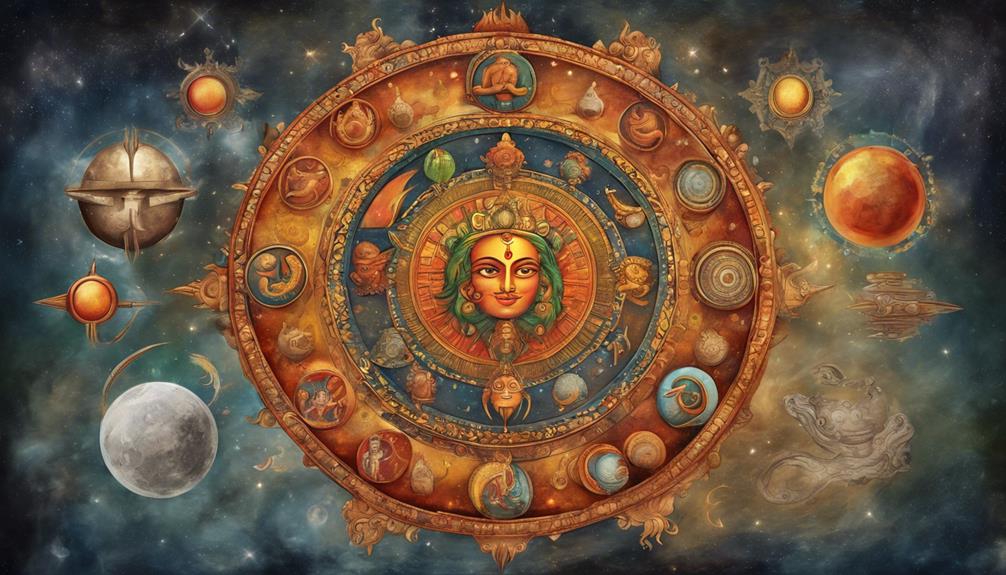
Delving into the intricate web of celestial alignments and cosmic influences, Hindu astrology establishes a profound connection between the movements of the Navagrahas and the destinies of individuals. In Hindu astrology practices, the Navagrahas, or nine celestial bodies, hold significant importance. These include the Sun (Surya), Moon (Chandra), Mars (Mangala), Mercury (Budha), Jupiter (Brihaspati), Venus (Shukra), Saturn (Shani), Rahu (North Lunar Node), and Ketu (South Lunar Node). Each of these planets is believed to emit specific energies that can influence an individual's life based on their placement in the birth chart.
The alignment of these Navagrahas at the time of one's birth is said to impact various aspects of life, including career, relationships, health, and overall well-being. Hindu astrology connects these planetary positions with one's past deeds and future destiny, emphasizing the karmic implications of celestial influences. This intricate system reflects the deep-rooted spiritual beliefs of Hindus, highlighting the interconnectedness between the cosmos and human existence. Through the study of these planetary movements, individuals seek insights into their life's journey and spiritual growth.
Significance in Hinduism
In Hinduism, the Navagrahas hold profound significance, intertwining celestial forces with human existence in a vital and interconnected web of spiritual beliefs and cosmic influences. These nine celestial bodies symbolize various aspects of life and are deeply embedded in cultural traditions and religious beliefs. Each of the Navagrahas represents a specific cosmic energy that influences human life, shaping destinies and guiding spiritual paths.
The Navagrahas play a pivotal role in Hindu astrology, reflecting the interconnectedness between the microcosm and the macrocosm. They're believed to govern different aspects of existence, from health and wealth to knowledge and relationships. People seek to appease these celestial deities through rituals and offerings to mitigate negative influences and enhance positive energies in their lives.
The symbolic significance of the Navagrahas extends beyond mere planetary bodies; they're seen as manifestations of divine forces that impact human destiny. By understanding and honoring the Navagrahas, individuals aim to establish a spiritual connection with the cosmos and align themselves with the harmonious flow of universal energies.
Influence on Daily Life
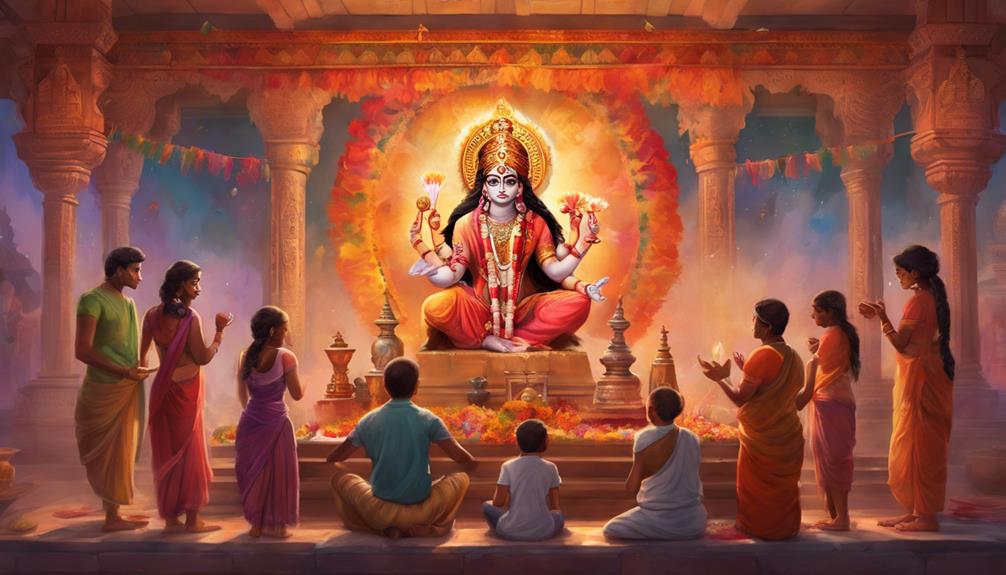
When contemplating the influence of Navagrahas on your daily life, it's essential to acknowledge the role they play in daily rituals.
These planetary deities provide astrological guidance that impacts various aspects of your daily routine.
Understanding their significance can help you navigate challenges and align your actions with cosmic energies for a harmonious life.
Daily Rituals and Navagrahas
How do the Navagrahas influence daily rituals and life in Hinduism?
Daily offerings and rituals play a significant role in appeasing the Navagrahas, aligning believers with positive energies and mitigating negative influences. Hindus perform specific practices based on each planet's astrological significance.
For instance, on Saturdays, devotees worship Lord Shani to pacify Saturn's effects, conducting rituals like lighting sesame oil lamps and offering black sesame seeds. Similarly, Tuesdays are dedicated to Lord Hanuman to counteract Mars' influence, with red flowers and sindoor (vermilion) being common offerings.
These rituals not only seek the Navagrahas' blessings but also aim to harmonize one's life with the cosmic energies represented by these celestial bodies.
Astrological Guidance and Navagrahas
The influence of Navagrahas on daily life in Hinduism manifests through astrological guidance, shaping rituals and practices to align individuals with cosmic energies. Astrological guidance offers a spiritual connection that aids in understanding how planetary influences affect personal growth.
Each Navagraha represents a celestial body with specific attributes that impact various aspects of life. By studying these planetary positions and their effects, individuals can gain insights into their strengths, weaknesses, and opportunities for growth.
Following astrological advice related to the Navagrahas can help in making informed decisions, choosing auspicious timings for important events, and maneuvering challenges effectively. This connection between planetary influences and daily life underscores the significance of seeking harmony with the cosmic forces for overall well-being and success.
Rituals and Offerings
Rituals and Offerings associated with the Navagrahas in Hinduism play a significant role in invoking blessings and seeking protection from planetary influences. Worship of the Navagrahas involves specific ceremonies and offerings tailored to each planetary deity. Devotees often perform rituals such as Navagraha Shanti Puja to mitigate malefic effects and enhance positive energies associated with the planets. Offerings like fruits, flowers, incense, and lamps are commonly made during these ceremonies as symbols of reverence and gratitude towards the Navagrahas.
Traditions surrounding the Navagrahas vary across regions, with each graha having distinct preferences regarding colors, objects, and days of worship. For instance, Tuesday is considered auspicious for Mars (Mangal), while Saturday is dedicated to Saturn (Shani). These rituals not only seek to appease the planetary influences but also aim to establish a harmonious relationship with the celestial bodies. Through these offerings and ceremonies, devotees express their devotion and seek guidance in maneuvering the cosmic forces that impact human life.
Temples Dedicated to Navagrahas
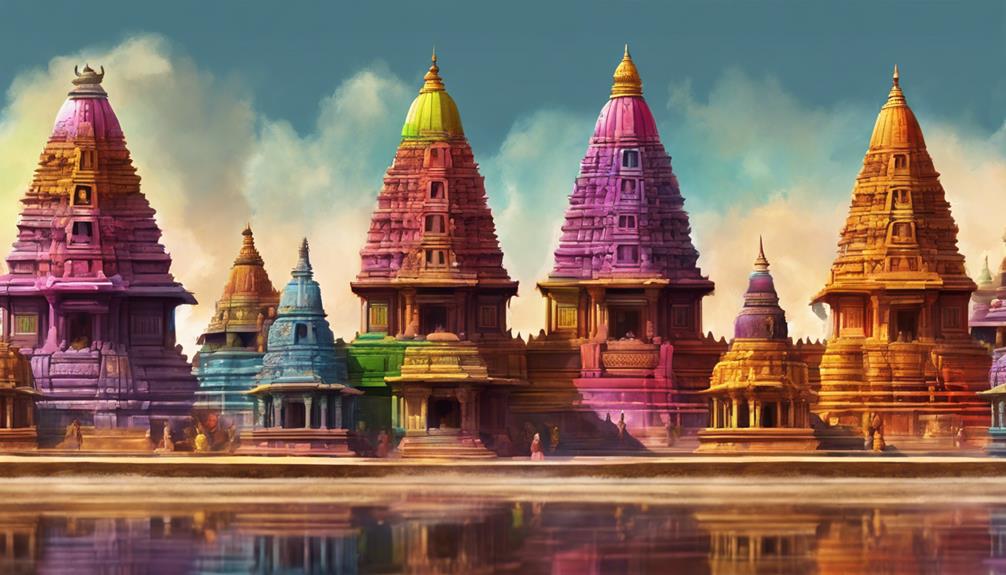
Dedicated temples to the Navagrahas stand as revered sanctuaries where devotees seek divine blessings and guidance from the planetary deities. These temples are meticulously designed, often reflecting ancient Hindu temple architecture with intricate carvings and detailed sculptures. The Navagraha temples typically house separate shrines for each of the nine celestial bodies, allowing worshippers to offer prayers and perform rituals specific to each planet.
Within these sacred spaces, worship traditions are meticulously followed to honor the Navagrahas. Devotees adhere to prescribed rituals, including lighting lamps, offering flowers, and reciting mantras associated with each planet. Many temples also conduct special pujas and homas to appease malefic planetary influences and seek blessings for a harmonious life.
Visiting Navagraha temples is believed to help mitigate the adverse effects of planetary positions and enhance the beneficial influences of the celestial bodies. The atmosphere in these temples is filled with devotion and reverence, creating a conducive environment for spiritual growth and seeking divine intervention in times of need.
Remedies for Malefic Effects
To counteract malefic effects attributed to unfavorable planetary positions, devotees often engage in specific remedial practices within the domain of Vedic astrology. One common remedy is the use of planetary gemstones believed to harness the energies of specific planets. For instance, wearing a blue sapphire for Saturn or a ruby for the Sun is thought to mitigate negative influences. Vedic rituals, such as homas (fire ceremonies) and pujas (worship rituals), are also performed to appease the planets and seek their benevolence.
Moreover, planetary yantras, geometric diagrams with mystical properties, are utilized as a way to connect with the energies of the planets and balance their effects. These yantras are often worshipped or meditated upon regularly to harmonize the planetary influences. Additionally, Ayurvedic remedies like specific herbal preparations or dietary adjustments are recommended to pacify malefic planetary influences on one's health and well-being. By incorporating these remedies into their daily practices, individuals seek to alleviate the adverse effects of malefic planets and enhance the positive energies in their lives.
Navagraha Mantras and Chants
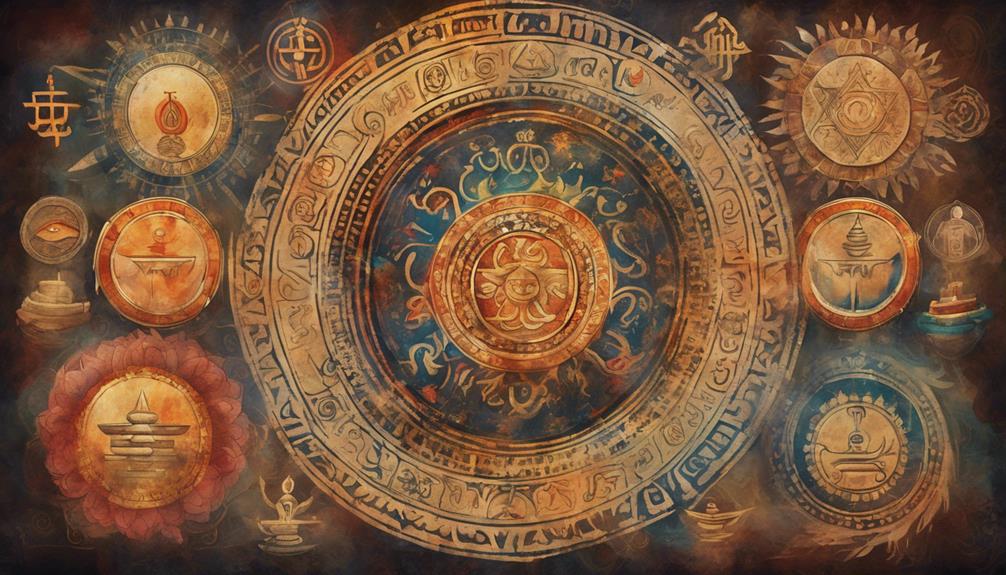
When exploring Navagraha Mantras and Chants, you'll uncover the profound significance behind these sacred utterances.
These mantras serve an important purpose in Vedic rituals, invoking the celestial energies associated with each planet.
Purpose of Mantras
Exploring the profound significance of Navagraha mantras and chants reveals the intricate role they play in Hindu rituals and spiritual practices. Navagraha mantras aren't mere words but powerful vibrations that hold the key to revealing spiritual domains.
Chanting these mantras offers numerous benefits, including establishing a deep spiritual connection with the celestial bodies and aligning oneself with their energies. The practice of mantra meditation using Navagraha mantras can lead to inner peace, harmony, and a sense of balance within the individual.
These sacred chants are a gateway to transcending the physical domain and tapping into the cosmic forces that govern the universe, allowing for personal growth and spiritual evolution.
Benefits of Chants
The profound impact of chanting Navagraha mantras extends beyond mere words, offering practitioners a gateway to profound spiritual growth and alignment with cosmic energies.
Engaging in meditation practices that involve chanting these powerful mantras can bring about spiritual benefits and healing effects. Through the repetition of these sacred sounds, individuals can experience a deep sense of connection with the energies of the nine celestial bodies, fostering inner peace and balance.
Chanting techniques, when done with sincerity and focus, have the potential to not only calm the mind but also evoke positive vibrations that resonate within the practitioner's being.
Rituals and Practices
Engage in daily rituals and practices centered around Navagraha mantras and chants to harness the cosmic energies of the celestial bodies for spiritual growth and alignment. Ritualistic practices play an important role in Hinduism, with Navagraha mantras holding significant spiritual significance.
By incorporating these sacred ceremonies into your daily routine, you can connect with the energies of the nine celestial bodies and seek their blessings. Chanting specific mantras for each Navagraha during auspicious times can help in mitigating the malefic effects of planets and enhancing their positive influences in your life.
These religious customs not only aid in seeking protection but also contribute to inner peace and harmony. Embrace the power of Navagraha mantras to enrich your spiritual journey and foster a deeper connection with the cosmic forces.
Devotion and Worship Practices
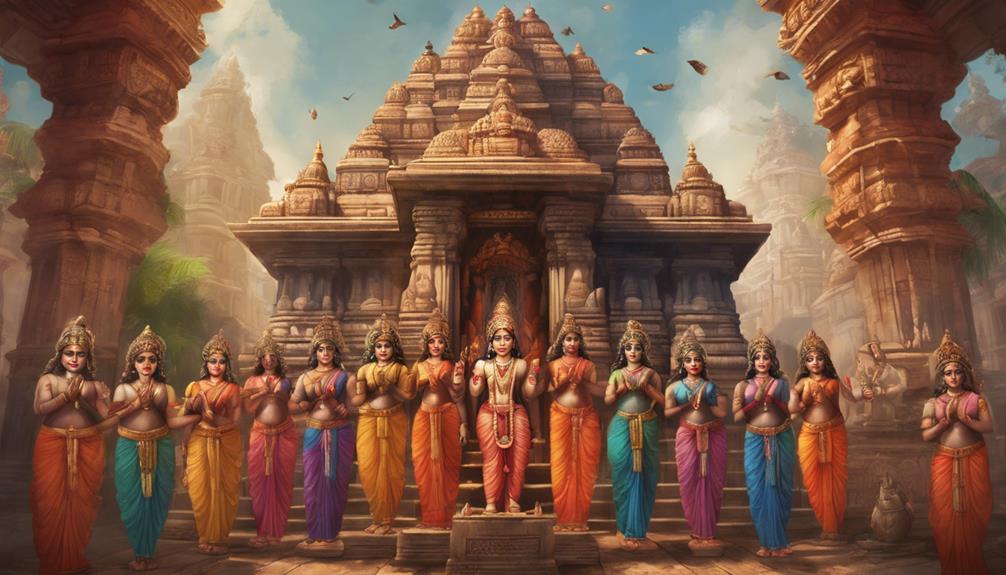
Immersing yourself in the intricate rituals of devotion and worship practices surrounding the Navagrahas in Hinduism reveals a profound spiritual connection to the celestial forces they represent. Bhakti practices, or spiritual devotion, play a central role in worshipping the Navagrahas. Devotees express their reverence through ritual ceremonies that involve chanting mantras, offering flowers, lighting incense, and presenting sacred offerings such as fruits, grains, and sweets to each of the nine planetary deities.
During these ceremonies, devotees seek blessings from the Navagrahas for protection, success, and overall well-being. The act of offering these items symbolizes a gesture of gratitude and respect towards the celestial bodies, acknowledging their influence on human life. Through these practices, individuals aim to cultivate a harmonious relationship with the Navagrahas, seeking their guidance and blessings in maneuvering life's challenges and opportunities.
Frequently Asked Questions
How Do the Navagrahas Impact Other Religious Practices in Hinduism?
The Navagrahas impact Hindu practices through astrological significance and rituals. They influence daily life and beliefs, shaping worship and ceremonies. Understanding their roles helps in finding auspicious timings and seeking divine blessings for various aspects of life.
Are There Any Specific Festivals Dedicated to the Navagrahas?
There are various festivals dedicated to the Navagrahas in Hinduism. People visit Navagraha temples during these occasions to seek blessings and offer rituals and offerings. The significance of these festivals lies in honoring the celestial deities.
Can the Navagrahas Be Worshiped Individually or Are They Always Worshiped Together?
You can worship the Navagrahas individually or collectively. Each planet has its unique characteristics and influences, allowing devotees to focus on specific aspects or seek overall blessings by honoring all nine celestial bodies together in Hinduism.
What Are Some Common Misconceptions People Have About the Navagrahas?
Common misconceptions about the Navagrahas often stem from oversimplified explanations or lack of understanding of their cultural significance. It's important to explore further into their roles and symbolism to appreciate their true importance.
How Do the Navagrahas Compare and Contrast With Other Celestial Bodies in Hindu Mythology and Astrology?
In Hindu mythology and astrology, the Navagrahas hold significant planetary significance. They are celestial bodies with mythological connections to deities, influencing astrological interpretations and religious practices. Understanding their roles aids in spiritual growth.
Conclusion
So, as you can see, the Navagrahas play a pivotal role in Hinduism, influencing various aspects of daily life and astrology. These nine celestial bodies hold immense significance in Hindu spirituality, with temples dedicated to them and remedies available for mitigating any negative effects.
By chanting Navagraha mantras and practicing devotion, individuals seek to harness the positive energies of these celestial bodies for their well-being and spiritual growth. The Navagrahas truly embody the interconnectedness of the cosmos and human existence in Hindu belief.